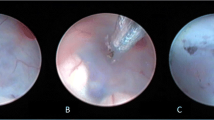Abstract
Object
The object of this study is to demonstrate the delayed occurrence of aqueductal stenosis in preterm infants who have suffered from intraventricular hemorrhage (IVH) and to try to explain the mechanisms of this stenosis.
Method
From January 1996 to June 2002, 1,046 premature infants were admitted to our institution. Thirty-six neonates suffered from grade 3 or 4 intraventricular hemorrhage (Papile grading), of whom 16 died. Twenty patients survived and a ventriculoperitoneal shunt was inserted in 7 infants. Four patients underwent a neuroendoscopic third ventriculostomy. Follow-up was carried out, twice a month during the first 2 months and subsequently twice a year.
Conclusion
In 2 children NTV was an effective treatment for hydrocephalus with an average follow-up of 29 months. The specific pattern concerning these patients is the long delay before obstructive hydrocephalus and the visualization of de novo obstruction with MRI. The biological explanation must be investigated.


Similar content being viewed by others
References
Beems T, Grotenhuis JA (2002) Is the success rate of endoscopic third ventriculostomy age-dependent? An analysis of the results of endoscopic third ventriculostomy in young children. Childs Nerv Syst 18:605–608
Bizzarri M, Filipo R, Valente MG, Bernardeschi D, Ronchetti F, Monini S, Chiappini I, Barbara M (2002) Release of transforming growth factor beta-1 in a vestibular schwannoma cell line. Acta Otolaryngol 122:785–787
Buxton N, Macarthur D, Mallucci C, Punt J, Vloeberghs M (1998) Neuroendoscopic third ventriculostomy in patients less than 1 year old. Pediatr Neurosurg 29:73–76
Buxton N, Macarthur D, Mallucci C, Punt J, Vloeberghs M (1998) Neuroendoscopy in the premature population. Childs Nerv Syst 14:649–652
Buxton N, Cartmill M, Vloeberghs M (1999) Endoscopic third ventriculostomy: outcome analysis of 100 consecutive procedures. Neurosurgery 45:957–959
Cinalli G (1999) Alternatives to shunting. Childs Nerv Syst 15:718–731
Garton HJ, Kestle JR, Cochrane DD, Steinbok P (2002) A cost-effectiveness analysis of endoscopic third ventriculostomy. Neurosurgery 51:69–77
Hudgins RJ (2001) Posthemorrhagic hydrocephalus of infancy. Neurosurg Clin N Am 12:745–753
Jellinger G (1986) Anatomopathology of non tumoral aqueductal stenosis. J Neurosurg Sci 30:1–16
McIntire DD, Bloom SL, Casey BM, et al (1999) Birth weight in relation to morbidity and mortality among newborn infants. N Engl J Med 340:1234–1238
Miyazawa K, Shinozaki M, Hara T, Furuya T, Miyazono K (2002) Two major Smad pathways in TGF-Beta superfamily signalling. Genes Cells 7:1191–1204
Miyazono K (2002) Regulation of transforming growth factor-beta signaling and vascular diseases. Cornea 21:S48–S53
Ogata H, Oka K, Mitsudome A (1992) Hydrocephalus due to acute aqueductal stenosis following mumps infection: report of a case and review of the literature. Brain Dev 14:417–419
Papile LA, Burstein J, Burrstein R, et al (1978) Incidence and evolution of subependymal and intraventricular hemorrhage: a study of infants with birth weights less than 1,500 gm. J Pediatr 92:529–534
Ransohof J, Shulman K, Fishman R (1960) Hydrocephalus. J Pediatr 56:399–411
Reinprecht A, Dietrich W, Berger A, Bavinzski G, Weiniger M, Cze T (2001) Posthemorrhagic hydrocephalus in preterm infants: long-term follow-up and shunt related complications. Childs Nerv Syst 17:663–669
Richard E, Cinalli G, Assis D, Pierre-Kahn A, Lacaze-Masmonteil T (2001) Treatment of post-haemorrhage ventricular dilatation with Ommaya's reservoir: management and outcome of 64 preterm infants. Childs Nerv Syst 17:334–340
Sarnat HB (1995) Ependymal reactions to injury. J Neuropathol Exp Neurol 54:1–15
Tahira Y, Fukuda N, Endo M, Suzuki R, Ikeda Y, Takagi H, Matsumoto K, Kanmatsuse K (2002) Transforming growth factor-beta expression in cardiovascular organs in stroke-prone spontaneously hypertensive rats with the development of hypertension. Hypertens Res 25:911–918
Thompson JA (1979) Mumps: a cause of acquired aqueductal stenosis. J Pediatr 94:923–924
Wellons JC III, Tubbs RS, Banks JT, Grabb B, Blount JP, Oakes Grabb PA (2002) Long term control of hydrocephalus via endoscopic third ventriculostomy in children with tectal plate glioma. Neurosurgery 51:63–67
Whitelaw A (2001) Intraventricular haemorrhage and posthaemorrhagic hydrocephalus: pathogenesis and future interventions. Semin Neonatol 6:135–146
Whitelaw A, Thorensen M, Pople I (2002) Posthaemorrhagic ventricular dilatation. Arch Dis Child Fetal Neonatal Ed 86:F72–F74
Acknowledgements
We are deeply indebted to Mark Krieger, MD, for his thoughtful help during the translation of this manuscript.
Author information
Authors and Affiliations
Corresponding author
Rights and permissions
About this article
Cite this article
Scavarda, D., Bednarek, N., Litre, F. et al. Acquired aqueductal stenosis in preterm infants: an indication for neuroendoscopic third ventriculostomy. Childs Nerv Syst 19, 756–759 (2003). https://doi.org/10.1007/s00381-003-0805-2
Received:
Published:
Issue Date:
DOI: https://doi.org/10.1007/s00381-003-0805-2




